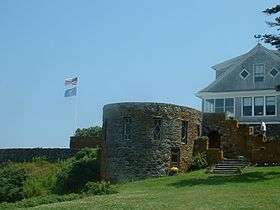Eagle Island (Casco Bay, Maine)
Eagle Island is an island in Maine's Casco Bay and the site of the retirement home of the polar explorer Admiral Robert Peary (1856-1920). The island and home are preserved as the Eagle Island State Historic Site.[1]
Eagle Island | |
 | |
  | |
| Nearest city | Harpswell, Maine |
|---|---|
| Coordinates | 43°42′40″N 70°3′10″W |
| Area | 17 acres (6.9 ha) |
| Built | 1904 |
| NRHP reference No. | 71000069 |
| Significant dates | |
| Added to NRHP | November 23, 1971 |
| Designated NHL | August 25, 2014 |
History
Peary bought the island in 1881 and retired there in 1911, after he had achieved fame and glory with his (sometimes disputed) expedition to the North Pole. His family continued to live in the house until the property was donated to the people of Maine in 1967. Eagle Island was listed on the National Register of Historic Places in 1971[2] and declared a National Historic Landmark in 2014.[3][4]
Description
- Island
The island is part of the town of Harpswell, in Cumberland County, and is located about 12 miles (19 km) northeast of Portland. Eagle Island is a 17-acre (6.9 ha) island in the outermost portion of the archipelago of islands that make up Casco Bay. Administratively part of Harpswell, it is 12 miles (19 km) northeast of Portland and 15 miles (24 km) south of Brunswick. The island has a maximum height of 40 feet (12 m) above sea level, and is rocky with a thin layer of topsoil. Most of the island is covered with conifers and brush; there are trails providing access to most of the island. The island was purchased by Admiral Peary in 1881. At the northern end of the island is a Y-shaped clearing in which the site's buildings are located, and a small beach area with a long wooden pier. There are three major structures on the island in addition to the pier: the Peary house, a caretaker's cabin, and a visitors center. The pier was constructed in 1969, and the visitors center in 2012.[5] The gardens planted by Mrs. Peary are maintained by park staff.[1]
- Estate
The Peary House is a wood frame house, built in several stages. The original portion of the house was built in 1904, and consisted of a rectangular structure with a single large living room on the first floor and three bedrooms on the second floor. Meals were prepared in the caretaker's house, an apparently inadequate situation that prompted the construction of a small kitchen and dining wing in 1906. A new fieldstone foundation with concrete piers was built, raising the structure onto a full-height basement, and shed-roof dormers were added to each side of the gabled roof. Following his retirement, Peary embarked on a further expansion of the building in 1912-13. The 1906 kitchen wing was detached, and a new expanded wing added, with a porch on three sides. Peary also built a pair of circular stone bastions, which served in part as a retaining wall to keep the house from being blown into the water during stormy weather. One of these bastions Peary used to house his artifact collection from his many expeditions.[5]
After Peary's death in 1920, his family made only modest alterations before giving the property to the state in 1967. The state built the pier and undertook restoration of the property, which had suffered deterioration due to weather. A portion of the Peary house's roof caved in in 1990, resulting in water damage to Peary's study, and necessitating reconstruction of that part of the house.[5]
See also
References
- "Eagle Island State Historic Site". Department of Agriculture, Conservation and Forestry. Retrieved December 11, 2015.
- John W. Briggs, Historian (November 23, 1971). "Eagle Island". National Register of Historic Places Inventory Nomination Form. National Park Service. Retrieved December 14, 2015.
- "Listing of National Historic Landmarks by State: Maine" (PDF). National Park Service. Retrieved December 11, 2015.
- "Secretary Jewell and Director Jarvis announced nine new national historic landmarks highlighting America's diverse history and culture" (Press release). National Park Service. September 30, 2014. Archived from the original on January 9, 2015. Retrieved January 8, 2015.
- Sheila McDonald (September 28, 2001). "National Historic Landmark Nomination: Eagle Island (The Admiral Robert E. Peary Summer Home)" (PDF). National Park Service. Retrieved January 8, 2015.
External links
- Eagle Island State Historic Site Department of Agriculture, Conservation and Forestry
- Friends of Peary's Eagle Island